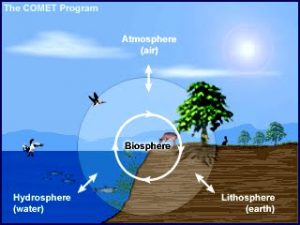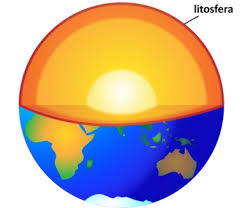Biosphere is the habitat of living organisms on our planet, including not only the surface of the Earth, but also the upper crust (. Lithosphere ), waters of rivers, lakes, seas, oceans ( hydrosphere) and the lower part of the atmosphere ( troposphere ).

According to modern data, the field of existence of life, especially active, is limited in the vertical limit about 6 km above sea level, to which positive temperatures in the atmosphere persist and green plants can live (6.2 km in the Himalayas). Only arthropods (beetles, springtails and some mites) that feed on grains of plant pollen, plant spores, microorganisms and other organic particles carried by the wind, etc., live above. Even higher living organisms get only by chance (microorganisms can save life in the form of spores). The lower limit of the existence of active life is traditionally limited to the bottom of the ocean and an isotherm of 100 ° C in the lithosphere, located respectively at elevations of about 11 km and, according to ultradeep drilling on the Kola Peninsula, about 6 km. In fact, life in the lithosphere is spread to a depth of 3–4 km.
There are some general patterns in the distribution of living organisms: from the poles to the equator, with increasing elevation in the mountains, increasing depth in water bodies. The data of such regularities are conveniently expressed both in quantitative characteristics of the species composition, and in biomass and its growth.
The increase in species diversity as it moved from north to south was formulated by L. Wallace (1823–1913) in 1859 and was named the Wallace rule.
The exact number of species of living organisms that live on our planet is not precisely defined, in the literature one can find a range of species from 1.7 (identified based on morphological, biochemical and genetic differences) to 30 million (forecast). More than 1.7 million species of organisms have been reliably identified: about 50 thousand types of bacteria, almost 100 thousand fungi, 300 thousand plants, 1 million 300 thousand animals. The total number of living organisms, according to some estimates, is from 10 26 to 10 30 .
The lithosphere is a stone shell of the Earth, including the Earth’s crust with a thickness (thickness) from 6 (under the oceans) to 80 km (mountain systems). The share of various rocks in the earth’s crust is not the same: more than 70% is accounted for by basalts, granites and other igneous rocks, about 17% are from rocks transformed by pressure and high temperature and only slightly more than 12% are sedimentary. The crust is the most important resource for humanity. It contains combustible minerals.
(coal, oil, oil shale), ore (iron, aluminum, copper, tin, etc.) and non-metallic (phosphate, apatite, etc.) minerals, natural building materials (limestone, sand, gravel, etc.).
Most of the known oil fields are dispersed in the following areas:
- 1) Persian Gulf – North Africa;
- 2) Gulf of Mexico – the Caribbean Sea (including the coastal areas of Mexico, the United States, Colombia, Venezuela and the island of Trinidad);
- 3) Islands of the Malay Archipelago and New Guinea;
- 4) Western Siberia;
- 5) North Alaska;
- 6) North Sea (mainly the Norwegian and British sectors);
- 7) about. Sakhalin with adjacent shelf areas.
The total natural gas reserves of our planet are about 271 trillion m 3 (10.5 million J), of which 139.4 trillion m 3 have been explored. For the entire period of gas production about 30 trillion m 3 have been extracted from the depths . Russia ranks first in the world in terms of gaseous fuel reserves.
The total resources of fossil coal in the depths of the planet are enormous and reach 14,810 billion tons. The main part of the coal-bearing basins is concentrated in the territory of the former USSR, in the USA, China. Poland, Germany, Australia, the United Kingdom and a number of other countries also have large reserves.
Hydrosphere – water shell of the Earth. It is divided into surface and underground.
The surface hydrosphere is the water shell of the surface part of the Earth. It includes the waters of the oceans, seas, lakes, reservoirs, swamps, glaciers, snow covers, etc. All these waters are permanently or temporarily located on the earth’s surface and are called surface waters.
The surface hydrosphere does not form a continuous layer and intermittently covers the earth’s surface by 70.8%. In some areas there is an excess of water, and in others – its deficit.
The underground hydrosphere includes waters located in the upper part of the earth’s crust. They are called underground. From above, the underground hydrosphere is bounded by the surface of the Earth, its lower boundary cannot be traced, since the hydrosphere penetrates very deep into the crust.
In relation to the volume of the globe, the total volume of the hydrosphere does not exceed 0.13%. The main part of the hydrosphere (96.53%) is the World Ocean. Groundwater accounts for 1.69% of the total hydrosphere, the rest is for rivers, lakes and glaciers.
Hydrosphere plays a huge role in the formation of the natural environment of our planet. It actively influences atmospheric processes (heating and cooling of air masses, saturating them with moisture, etc.). The Earth is the only planet of the Solar System, which has a powerful and complex water envelope, which is probably why life originated on it and survived, there is a biosphere.
According to GOST 19179–73, water resources are reserves of surface and groundwater of any territory. The total water reserves on Earth are 1.5 billion km 3 . Of these, less than 2% refers to freshwater, and to available for use – not more than 0.3 % K
Terminology problems
Water is used by many sectors of the economy, which in this respect can be divided into water users and water users. Water consumers take water from water bodies, consume it to produce industrial and agricultural products and electricity, as well as for household needs of the population, and return it to water bodies elsewhere and usually in smaller quantities and of poorer quality. Water users do not withdraw water from water bodies and do not use water itself, but its energy, or use water as a medium or landscape element (for example, hydropower, water transport, fisheries, water sports) 2 .
The contribution of hydropower to global global energy use is small, about 6%. However, in a number of countries of the world, hydropower takes the leading place. The share of hydropower in Norway accounts for about 100% of the total electricity production, in Brazil, Canada, Sweden – more than 50%, in Russia – about 20%. In terms of hydropower potential, Russia ranks second, second only to China. If in the industrially developed European part of Russia about 45% of the available hydro potential is mastered, then for the Far East this value is only about 4%.
Atmosphere (Greek “atmosphere” – steam) is the gas shell of the Earth, consisting of a mixture of various gases, water vapor and dust. The most important is the ratio of gases in the atmosphere: the content of oxygen, water vapor, carbon dioxide, pollutants.
At first, the Earth had an atmosphere similar to that of Venus, where C0 2 , CO, S0 2 , N 2 0, CH 4 , H 2 and, possibly, H 2 S 3prevailed . Later, the atmospheric air became largely a product of the vital activity of organisms. The atmosphere is dominated by nitrogen (just over 78%), oxygen (almost 21%), argon (approximately 0.93%), carbon dioxide (approximately 0.03%); other gases that are part of the atmosphere, presented in even smaller quantities. Oxygen created the ozone shield, which allowed life to go to land. The turnover of air oxygen through biota is several thousand years, and carbon dioxide is about 10 years 4 .
Currently, the concentration of minor gas components of air (carbon dioxide, sulfur and nitrogen dioxide, etc.) is increasing as a result of economic activity. New substances have appeared in the air, for example, freons that destroy the ozone layer, protecting the terrestrial inhabitants of the planet from excessive ultraviolet radiation. [one]
The weather and climate on Earth depend on the distribution of heat, pressure, and water vapor in the atmosphere. Water vapor absorbs solar radiation, increases the density of air and is the source of all precipitation.
